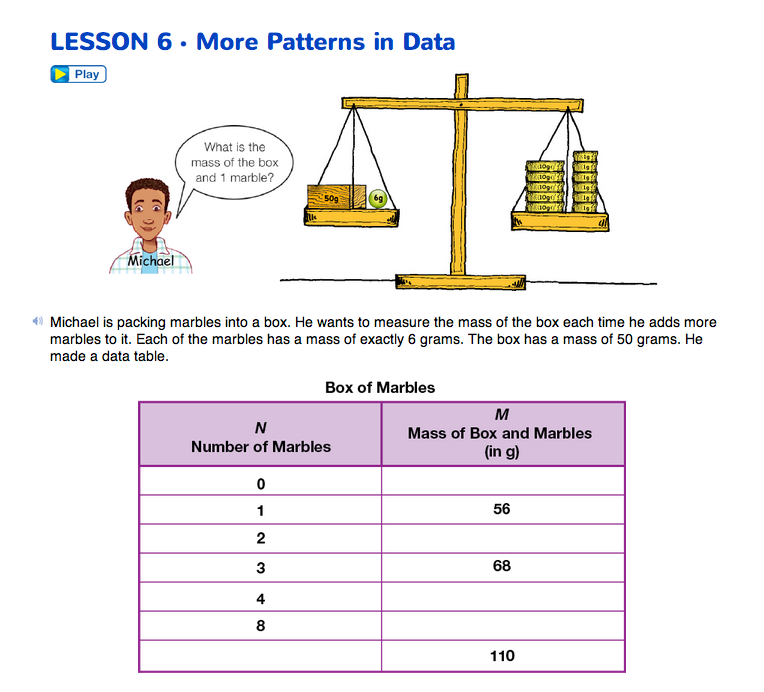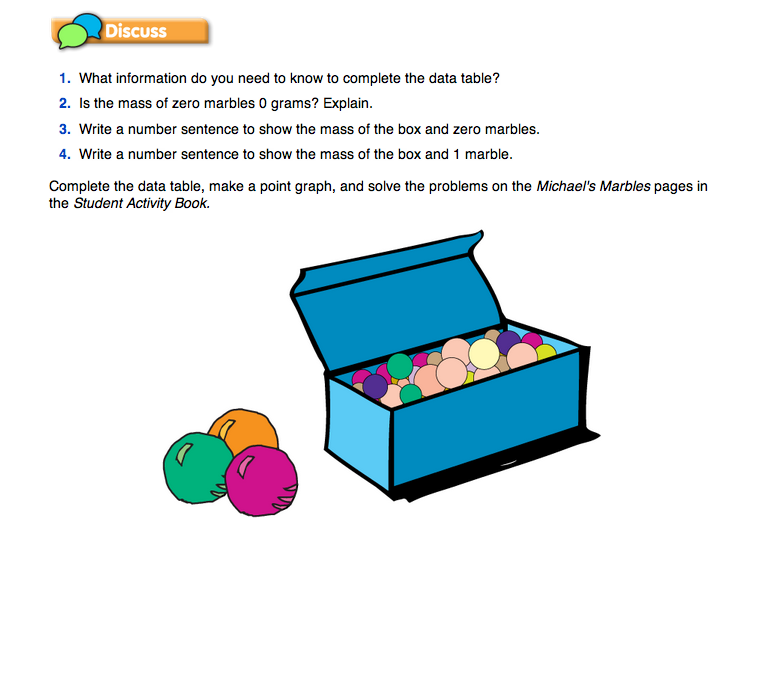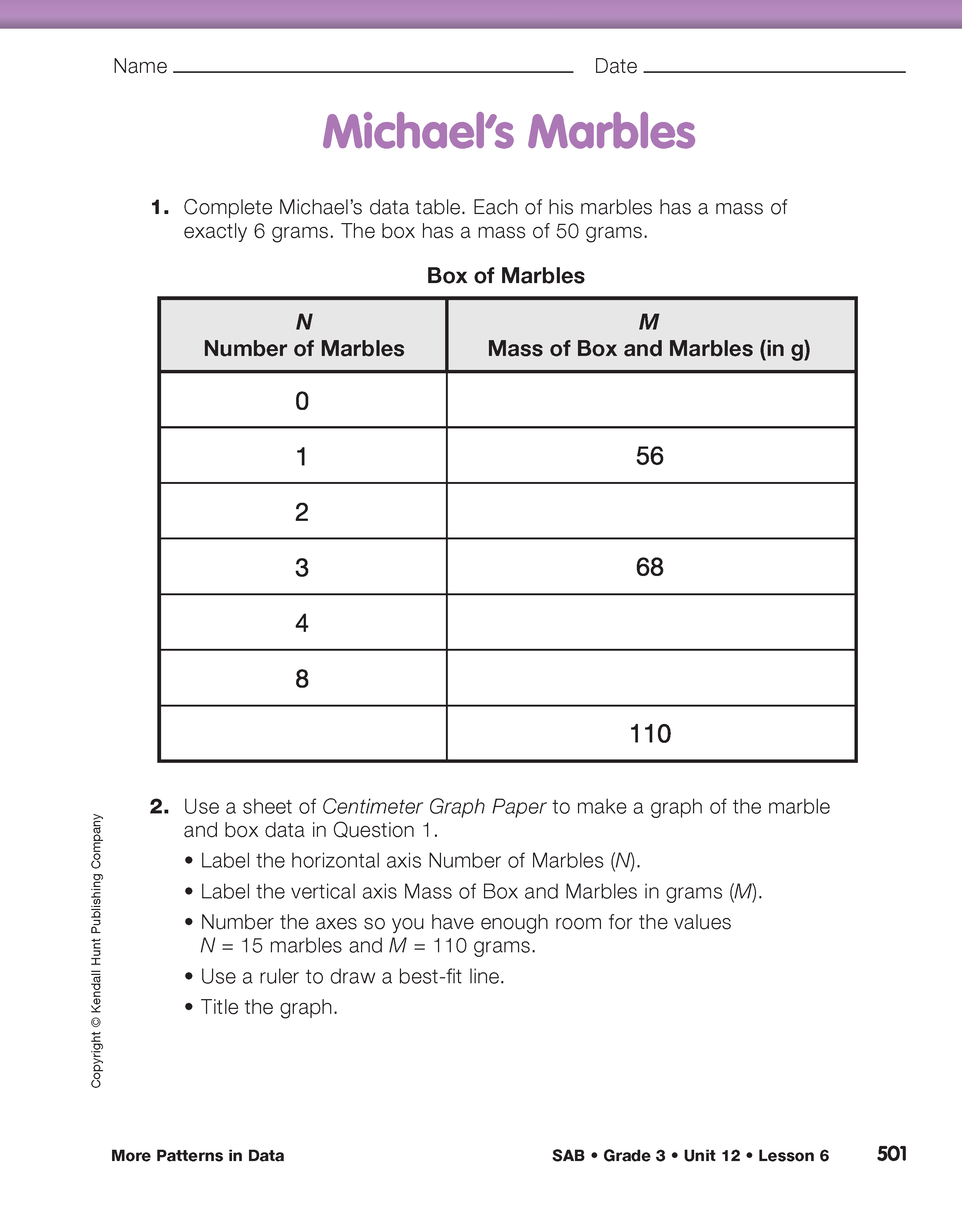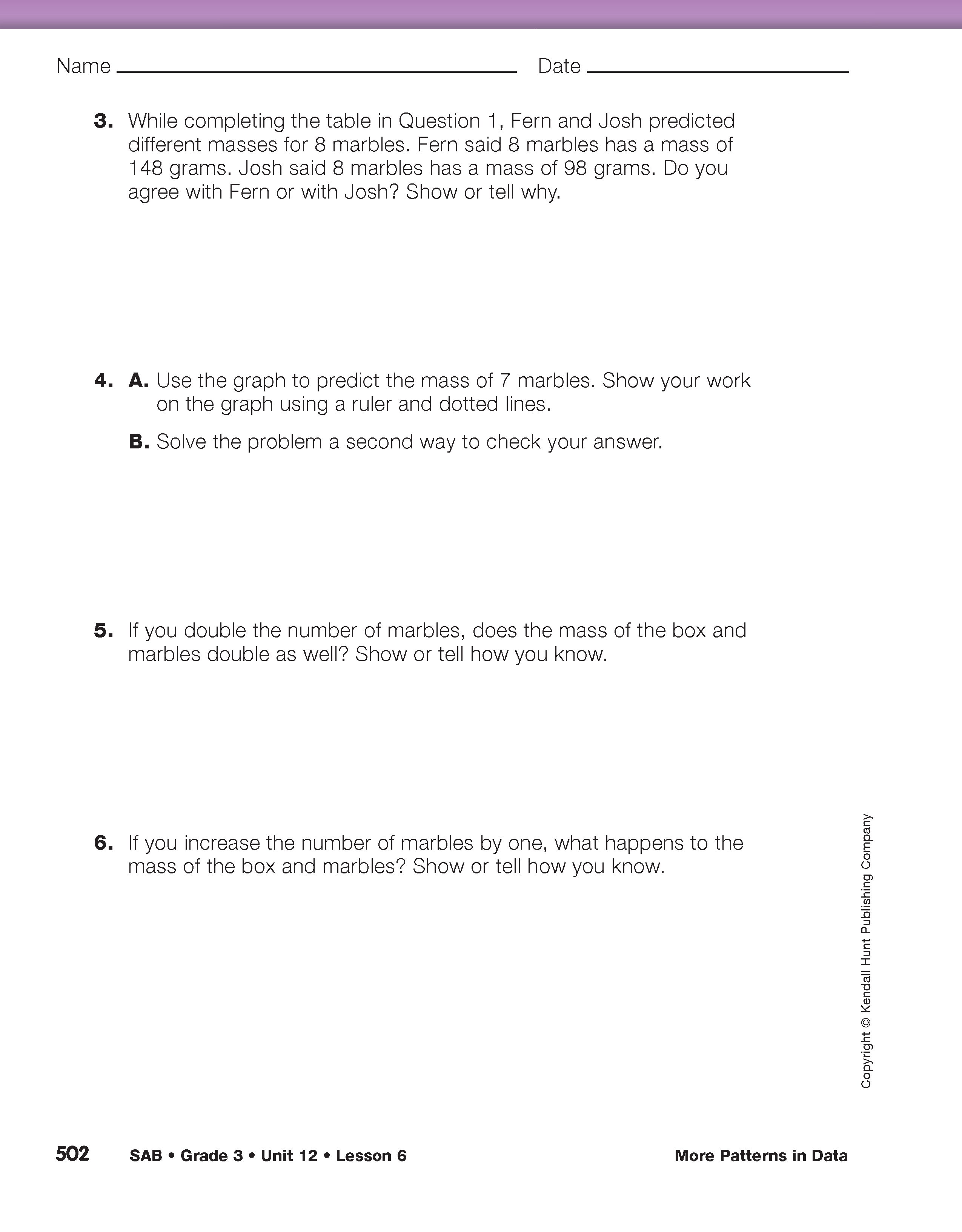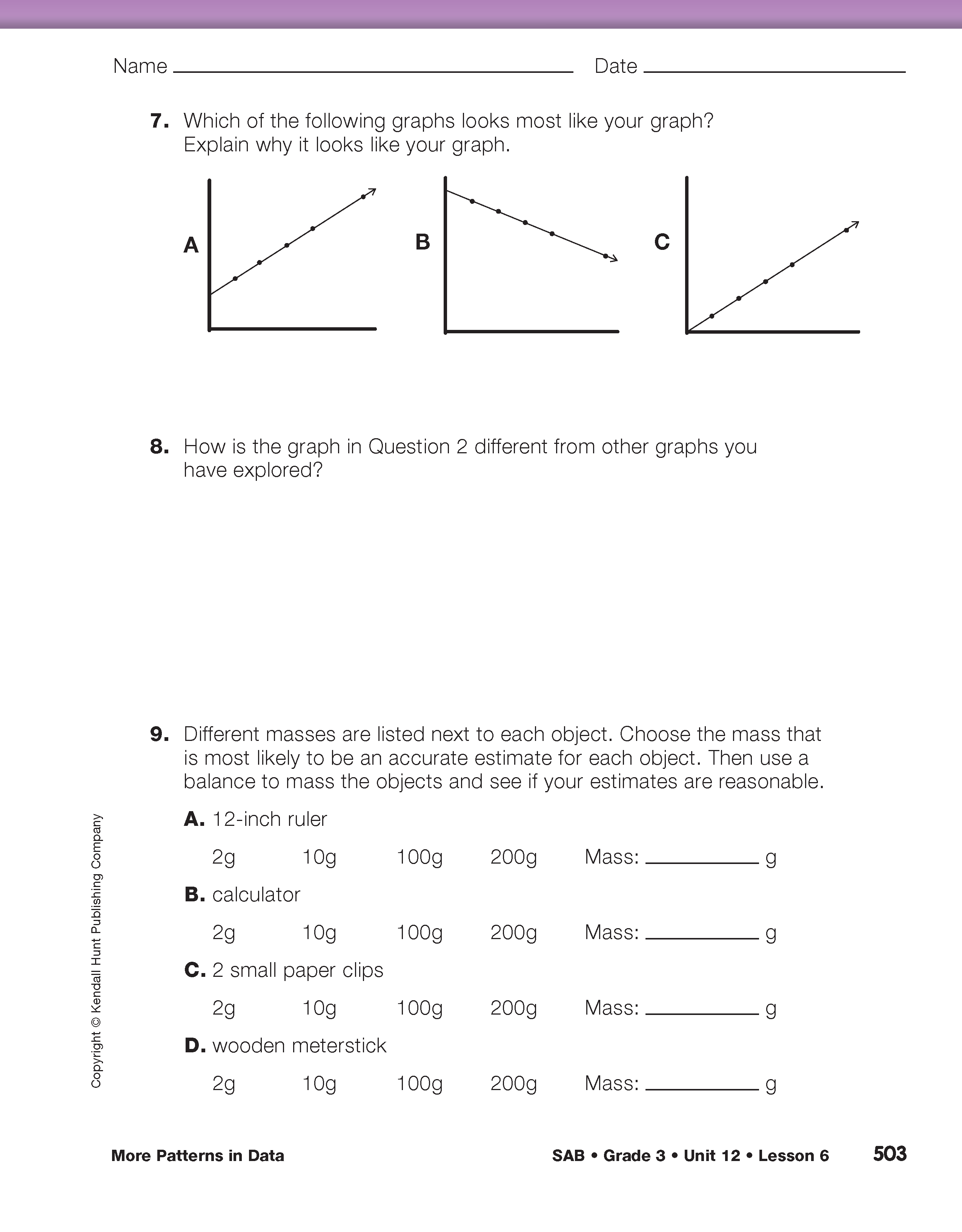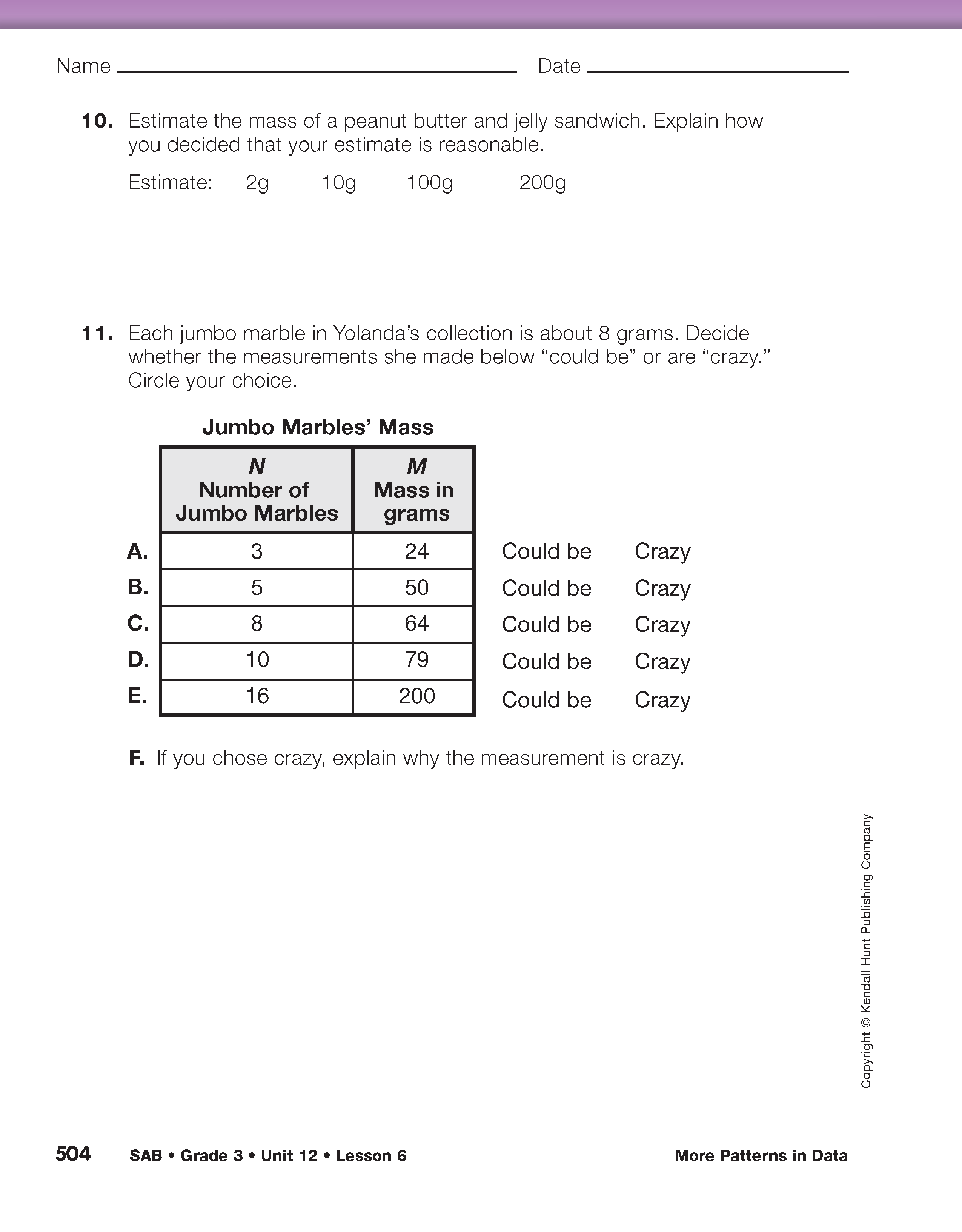Find Patterns in Data Tables. Direct students' attention to the More Patterns in Data page in the Student Guide. On this page, Michael is packing 6-gram marbles into a box that has a mass of 50 grams. He records the mass of the box and the marbles each time he adds marbles to the box. This data differs from other data sets students have analyzed. In this data set, the value for the mass of zero marbles is greater than zero because the marbles are weighed in the box and the box itself has a mass of 50 grams. When the data is graphed, the best-fit line will not go through the origin.
Read the short vignette together and assign Questions 1–4 to student pairs to facilitate discussion.
- What information do you need to know to complete the data table? (I need to know the number of marbles in the box, that the mass of each marble is 6 grams, and that the mass of the box is 50 grams.)
- In this problem, is the mass of 0 marbles 0 grams? Explain. (No, because the mass of the empty box is 50 grams.)
- Write a number sentence to show the mass of the box and zero marbles. (50 grams + 0 grams = 50 grams)
- Write a number sentence to show the mass of the box and 1 marble. (50 grams + 6 grams = 56 grams)
- What do the numbers in the number sentence represent? (50 stands for the mass of the box in grams and 6 stands for the mass of 1 marble in grams.)
Use Patterns in Tables and Graphs. Direct students' attention to the Michael's Marbles pages in the Student Activity Book. Students will use patterns to complete the data table and a point graph and to then solve problems. Have two-pan balances and standard masses available for Question 9–11. Students estimate the mass of various objects, measure mass, and decide whether measurements are reasonable based on patterns in a data table. Have several calculators, wooden metersticks, 12-inch plastic rulers, and paperclips available for students to mass. See Material Preparation.
Distribute copies of the Centimeter Graph Paper Master. Assign Questions 1–11 to student pairs. Remind students to clearly show or tell how they used tools to solve the problems and to explain how they checked their predictions. Students should include labels in their explanations and use dotted lines to show how they used the graph.
Students can work on the problems individually, in pairs, or in groups. One approach is to ask students to work on the problems individually first and then come together in pairs or small groups to compare solutions. Then the group's solutions can be shared with others in a class discussion.
- What pattern do you see when you look across the rows in Michael's data table? (The number of marbles times 6 plus 50 results in the mass of the box and the marbles.)
- Write a number sentence to show the mass of the box and 2 marbles. (50 + 6 + 6 = 62 grams or 50 + 6 × 2 = 62 grams)
- What does each of the numbers in the number sentence represent? (50 is the mass of the box, the two 6s are for the mass of the 2 marbles, and the 62 is for the mass of the box together with the mass of the 2 marbles.)
- If I know that the mass of 2 marbles and the box is 62 grams, can I double that to find the mass of 4 marbles and the box? (Possible response: No, because only the mass of the marbles doubles. The mass of the box does not. If you doubled 62, you would have an extra 50 grams.)
- Write a number sentence to show the mass of the box and 4 marbles. (50 + 6 + 6 + 6 + 6 = 74 grams or 50 + 6 × 4 = 74 grams)
Show a display of the Math Practices page in the Student Guide Reference section. Tell students to think about how they used the Math Practices when solving the problem in Question 4.
- Think about the tools and strategies you used to answer Question 4 [MPE2 and MPE5]. How did you use the graph to predict the mass of 7 marbles? Show your work. (Students can use a display of their graph. Find 7 marbles on the horizontal axis; draw a dashed line straight up until it meets the best-fit line. Draw a straight dotted line to meet the vertical axis at 92 grams.)
- Use another tool or strategy to check for reasonableness [MPE3]. (Possible response: Using the data table, I know that the mass of 8 marbles and the box is 98 grams. If I take one marble away it is 98 grams − 6 grams = 92 grams.)
- What labels did you include in your explanation [MPE6]? (marbles, grams)
- If I know that the mass of the box and marbles is 110, can I just divide 110 by 6 to find the number of marbles in the box? Why or why not? (No. The mass of the box needs to be subtracted first. 110 − 50 = 60 and then you can find that 60 ÷ 6 = 10.)
- Solve the problem a second way to check your solution. (Possible solution: 50 + 6 × 10 = 110 grams or 50 + 6 + 6 + 6 + 6 + 6 + 6 + 6 + 6 + 6 + 6 = 110 grams)
Question 8 asks students to describe how this graph is different than other graphs they have seen to highlight how the mass of the box is represented in the graph.
- Where is the mass of the box represented in the data table? (The mass of the box is in the first row. It is 50 grams with 0 marbles.)
- Where is the mass of the box represented on the graph? (It is at the point for 0 marbles on the horizontal axis and 50 grams on the vertical axis.)
- How is this graph different from ones you have worked with before? Why? (The first data point does not start at 0,0. The best-fit line does not go through the origin. Even though 0 marbles has a mass of 0 grams, you have a 50 gram box, so the total mass of the marbles and box is 50 grams.)
- Graphs B and C in Question 7 do not match this situation. Why not? (Graph B does not show that the mass of the box and marbles increases as you add more marbles. The first data point for Graph C is at 0,0. It does not show that the box with 0 marbles has a mass of 50 grams.)
- How did you know that your estimate of the mass of a sandwich was reasonable? (Possible response: I found an object that seemed to have a similar mass and used a two-pan balance to find its mass. The mass of a calculator was 90 grams, so I knew my estimate of 100 grams was reasonable.)

Word Problems. As students encounter different kinds of word problems in their mathematical studies, they will learn to use diverse and effective problem-solving tools.













